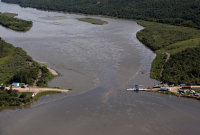Support strong Canadian climate journalism for 2025
The oil spill in Saskatchewan could increase public skepticism of pipeline projects, says the CEO of TransCanada, the company behind the proposed Energy East Pipeline.
"All of these incidents shake public confidence," Russ Girling said in an interview. "There's no question that things like that cause people concern, and rightfully so."
Last week, a Husky Energy pipeline spilled between 200,000 and 250,000 litres of oil into the North Saskatchewan River, leaving cities along the waterway scrambling to find non-tainted sources of drinking water.
Girling said TransCanada (TSX:TRP) will be keen to learn from the Husky incident to improve pipeline safety.
"From all incidents, both ours and other incidents around our industry, we learn from them — certainly around moving water, that is one of our biggest risks," said Girling.
He said the company has implemented numerous safety improvements in recent years around waterways, including thicker pipelines at crossings, drilling pipes under rivers at times, and adding extra valves at crossings so that it can shut off a pipeline faster.
"There's numerous things that we have put in place over the last decade or so which considerably change the risk of moving across or moving underneath moving water," he said.
The Husky spill comes as public hearings are set to begin on Energy East on Aug. 8 in Saint John, N.B.
The project has faced significant opposition from environmentalists, including a campaign launched earlier this week led by the Natural Resources Defence Council warning of the environmental threat posed by the anticipated increase in tanker traffic on the East Coast.
The proposed $15.7 billion pipeline would move 1.1 million barrels of oil a day from Alberta and Saskatchewan through Quebec and into New Brunswick to supply Eastern Canada refineries and for overseas shipping.
The development would lead to an estimated 281 tankers a year heading to the proposed Energy East terminal near Saint John, an increase of upwards of 300 per cent to the number of tankers now in the Bay of Fundy, according to the NRDC campaign.
Girling dismissed the campaign, saying it is concerned only with keeping oilsands crude in the ground rather than what's necessarily best for the environment or safety.
"There's no compromise in these folks," he said. "There's no logic, no rhyme or reason, rationale, science, to what they put forward."
TransCanada continues to push ahead with Energy East, but it also has a wide range of other major initiatives underway, including expansion in Mexico and consolidating its recent US$13 billion acquisition of the Columbia Pipeline Group.
The acquisition of the pipeline company — announced in March and closed on July 1 — adds a 24,000-kilometre pipeline network that stretches from New York to the Gulf of Mexico.
Costs related to the Columbia acquisition weighed on company earnings in the quarter, which were down nearly 14 per cent from last year to a net income of $365 million.



Comments